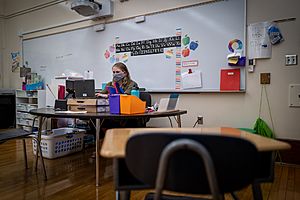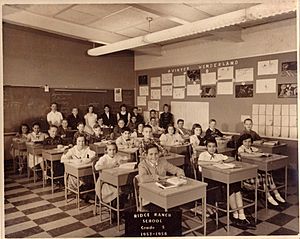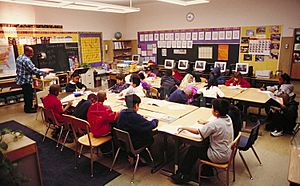Elementary schools in the United States facts for kids
An elementary school is where kids in the United States get their first education. It's also called a primary school. Most students go to elementary school from around age 5 to 11. This usually means starting in kindergarten and going through fifth grade.
After elementary school, students move on to middle school or high school. In 2017, over 35 million students were in public elementary schools across the country.
Contents
A Look Back: How Elementary Schools Changed
Long ago, elementary schools often taught children from kindergarten all the way through eighth grade. High school then covered grades 9 to 12. This was common until after World War I. Many children, especially in rural areas, didn't go past eighth grade. High schools were not always easy to reach.
As more people moved to cities and suburbs, the one-room schoolhouse changed. Schools grew bigger, with many classrooms. This led to the creation of junior high schools. These schools helped students get ready for high school.
Junior High to Middle School
Junior high schools often included grades 7 to 9. Elementary schools usually ended at grade 6. By the late 1960s, junior high schools started to become middle schools. In many places today, middle schools include grades 6, 7, and 8. This means elementary school often finishes at grade 5. However, some areas still use the older system.
Different Ways of Learning
Over the years, schools have tried new ways to teach. Instead of one teacher for one class, some schools have "multi-age programs." This is where students from different grades, like kindergarten and second grade, learn together. They share the same classroom and teachers.
Another idea is for students to switch teachers for certain subjects. For example, you might have a main teacher but go to another room for science. The science teacher's main class might then go to your main teacher for social studies. This is sometimes called a "rotation" or "teams."
What You Learn in Elementary School
Elementary school focuses on teaching you important basics. These are skills you need for life and for secondary school. You learn how to read, write, and do math. You also learn about science, history, and art.
Core Subjects
In elementary school, you'll learn:
- Mathematics: Basic arithmetic and sometimes simple algebra.
- English: Reading, grammar, spelling, and new vocabulary.
- Science: The basics of how the world works.
- Social Studies: About history, geography, and how people live together.
You might also have classes for physical education, music, and art. Most of the day, you stay with your main classroom teacher. But you often go to special teachers for subjects like art or music.
Learning Standards
Each state has "learning standards" for what students should know in each subject. These standards make sure that all students learn important skills. The No Child Left Behind Act helped make sure these standards were in place.
Who Teaches in Elementary School?

Elementary school teachers usually have a special college degree. It's often a bachelor's or master's degree in Early Childhood and Elementary Education.
A typical public elementary classroom has about 20 to 30 students. Teachers work with all kinds of learners. This includes students who need extra help and those who are very talented. Teachers use many different ways to teach. They try to make learning fun and interesting. Sometimes, they even use humor or cartoons to explain ideas!
Images for kids
-
A preserved one-room school located in Wells, Maine.






